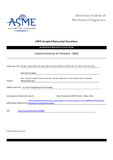JavaScript is disabled for your browser. Some features of this site may not work without it.
| dc.contributor.author | Hossain, Md. J. | |
| dc.contributor.author | Chowdhury, Jahedul Islam | |
| dc.contributor.author | Balta-Ozkan, Nazmiye | |
| dc.contributor.author | Asfand, Faisal | |
| dc.contributor.author | Saadon, Syamimi | |
| dc.contributor.author | Imran, Mohammad | |
| dc.date.accessioned | 2021-02-01T16:15:01Z | |
| dc.date.available | 2021-02-01T16:15:01Z | |
| dc.date.issued | 2021-01-29 | |
| dc.identifier.citation | Hossain MJ, Chowdhury JI, Balta-Ozkan N, et al., (2021) Design optimization of supercritical carbon dioxide (s-CO2) cycles for waste heat recovery from marine engines. Journal of Energy Resources Technology, Volume 143, Issue 12, December 2021, Article number 120901 | en_UK |
| dc.identifier.issn | 0195-0738 | |
| dc.identifier.uri | https://doi.org/10.1115/1.4050006 | |
| dc.identifier.uri | https://asmedigitalcollection.asme.org/energyresources/article/doi/10.1115/1.4050006/1097038/Design-optimization-of-supercritical-carbon | |
| dc.identifier.uri | https://dspace.lib.cranfield.ac.uk/handle/1826/16286 | |
| dc.description.abstract | The global climate change challenge and the international commitment to reduce carbon emission can be addressed by improving energy conversion efficiency and adopting efficient waste heat recovery technologies. Supercritical carbon dioxide (s-CO2) cycles that offer a compact footprint and higher cycle efficiency are investigated in this study to utilize the waste heat of the exhaust gas from a marine diesel engine (Wärtsilä-18V50DF, 17.55 MW). Steady-state models of basic, recuperated and reheated s-CO2 Brayton cycles are developed and optimised for net work and thermal efficiency in Aspen Plus to simulate and compare their performances. Results show that the reheated cycle performs marginally better than the recuperated cycle accounting for the highest optimised net-work and thermal efficiency. For the reheated and recuperated cycle, the optimized net-work ranges from 648–2860 kW and 628–2852 kW respectively, while optimized thermal efficiency ranges are 15.2–36.3% and 14.8–35.6% respectively. Besides, an energy efficiency improvement of 6.3% is achievable when the engine is integrated with an s-CO2 waste heat recovery system which is operated by flue gas with a temperature of 373 °C and mass flow rate of 28.2 kg/s, compared to the engine without a heat recovery system. | en_UK |
| dc.language.iso | en | en_UK |
| dc.publisher | American Society of Mechanical Engineers | en_UK |
| dc.rights | Attribution 4.0 International | * |
| dc.rights.uri | http://creativecommons.org/licenses/by/4.0/ | * |
| dc.subject | energy conversion/systems | en_UK |
| dc.subject | energy systems analysis | en_UK |
| dc.subject | heat energy generation/storage/transfer | en_UK |
| dc.subject | power (co-) generation | en_UK |
| dc.title | Design optimization of supercritical carbon dioxide (s-CO2) cycles for waste heat recovery from marine engines | en_UK |
| dc.type | Article | en_UK |
Files in this item
The following license files are associated with this item:
This item appears in the following Collection(s)
-
Staff publications (SATM) [4365]

